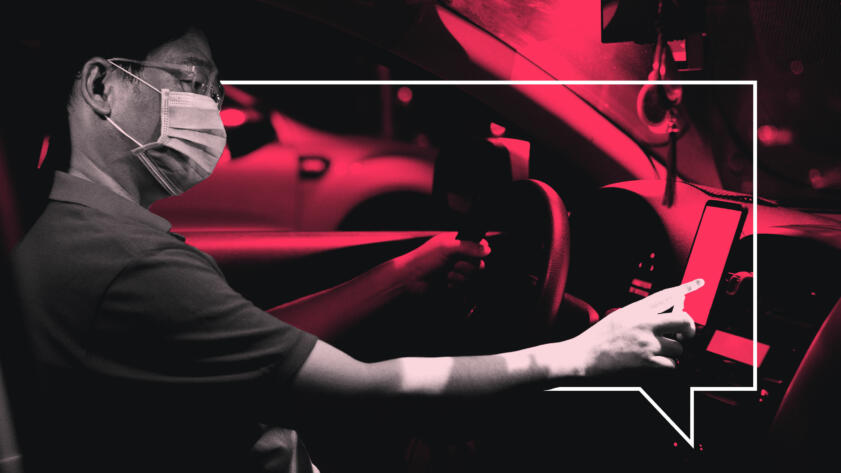By 11 o’clock on the morning of April 29, Don Creery, a 66-year-old Uber driver and union activist in Seattle, had been on hold for two and half hours with Washington State’s Employment Security Department. His voice was all ragged edges; he couldn’t think straight, he said. “Yesterday, I was already two and a half hours on hold, then the call just ended.” Creery had applied for state unemployment benefits nearly a month and a half earlier, when rides suddenly evaporated, but had been “approved” for $0.
Throughout the country, the legal status of gig workers like Creery is unsettled: Are they employees or independent contractors? It’s a distinction sharpened by the joblessness caused by COVID-19, since only employees who receive a W-2 are typically eligible for unemployment benefits. Uber maintains that drivers are freelancers and thus pays nothing in unemployment insurance premiums; nor does the company transmit individual work records to state relief agencies.
But in recent years, some Uber and Lyft drivers in Washington have managed to obtain unemployment benefits, according to Local 117 of the Teamsters union, which organizes for-hire drivers—and, during the pandemic, the state has encouraged gig workers to apply. So Creery did, taking 70 screenshots of the weekly earnings messages on his app to prove that he met the minimum requirement: 680 hours worked over the previous 18 months.
In late March, after Creery submitted his application, the federal government created Pandemic Unemployment Assistance (PUA) under the CARES Act to cover otherwise ineligible workers. PUA would provide jobless freelancers and independent contractors with a portion of their weekly earnings, up to the state maximum, plus a temporary bonus of $600 for most recipients of state and federal unemployment. Uber and Lyft pushed their drivers toward the federal program, but Creery and many others would receive much less under PUA, which is based on net income, rather than gross.
The Washington application was the same in either case and still needed to be processed by an overloaded Employment Security Department. In some other states, it took more than a month before PUA applications could be processed. Pennsylvania started accepting claims for federal benefits on May 7; Arkansas began doing so on May 5.
Over the past two months, more than 30 million Americans—one in five workers—have filed initial claims for unemployment relief, and that’s likely a severe undercount of the out-of-work population, economists say. Phone lines and online application portals now clog or crash more often than function, as workers, employers, and bureaucrats try to get hold of programs that reinvent themselves every hour. John Tirpak of the Unemployment Law Project, in Seattle, said that “the problems have been constant” when it comes to gig workers in particular. “There have been a bunch of webinars, but I’ve gotten contradictory information, so I’m not even sure what to tell people.”
A Faster Result or a Just Result?
Where PUA is up and running, gig workers may face a confounding choice: Do they pursue PUA or regular unemployment? According to Brian Chen of the National Employment Law Project, most states are processing app-based workers for PUA, by default, in order to draw on federal funds and avoid the headache of deciding whether, for example, an individual Uber driver is an employee or independent contractor.
And because companies like Uber and Lyft have held up PUA as the best and fastest way to access relief, drivers desperate for help may settle for whatever benefits come their way. In 2018, New York ruled that app-based workers must be treated as regular employees for purposes of unemployment, but at the moment, it isn’t clear how the state’s labor department is dealing with their claims. Deanna Cohen, the department’s deputy director of communications, offered only that “everyone’s work history is unique, including gig/digital marketplace workers.… If an individual is not eligible for regular UI, they will likely be eligible for PUA.”
Bhairavi Desai, director of the New York Taxi Workers Alliance, said that she and her colleagues have recently spoken with dozens of Uber and Lyft drivers whose applications seem to be stuck; they have received neither state benefits nor PUA and cannot afford their groceries or rent as a result.
As in Creery’s case, however, a full-time platform worker who gets PUA (net income) instead of state unemployment (gross income) could stand to lose a great deal. Veena Dubal, a law professor at UC Hastings, in San Francisco, said that one local driver reported his gross earnings to be $88,000; his net: just $22,000. She also noted that routing gig workers through PUA lets app companies off the hook and burdens underfunded governments: “We have no accounting of how many drivers went through the [state] portal and how much money taxpayers are fronting because these employers are refusing to pay into unemployment insurance.”
Last year, New Jersey billed Uber for $649 million in unpaid unemployment and disability contributions—but has yet to collect; the company disputed the fine, restating its position that its drivers are not employees. New Jersey’s Department of Labor and Workforce Development did not respond to requests for comment.
Employees or Independent Contractors?
The classification of gig workers as independent contractors has led to another problem, now on full view in California. Uber and Lyft drivers who work another, traditional job, for which they receive a W-2, may get stuck in an arcane gap between regular unemployment and PUA. If, in any quarter over the previous 18 months, an applicant was paid $1,300 or more in W-2 wages, that employment, rather than any 1099 labor, would guide the benefits calculation. A worker who earned $50,000 on an app but only $5,000 from a catering stint could therefore miss out on hundreds of dollars per week in PUA.
This would not be a problem, of course, if platform work were enforced as W-2 employment, and on May 5, California filed suit against Uber and Lyft for “inappropriately classifying massive numbers” of drivers as independent contractors. Uber promised to fight the lawsuit; Lyft said it looked forward “to working with” state officials. Administrators in Washington and Illinois are processing app-based workers for regular unemployment benefits on a case-by-case basis. Nick Demerice, a spokesperson for Washington’s Employment Security Department, said that “some gig workers qualify in Washington for UI while some for PUA.”
For both forms of unemployment, documentation presents a challenge. In principle, Creery, the driver in Seattle, should have had an easy time applying. By filling out the form online, he would trigger Uber’s submission of a 1099 tax form and a detailed statement of hours and pay to the Employment Security Department. But neither Uber nor Lyft has relayed that information to state agencies.
When asked why Uber chose not to do so, Matthew Wing, a company spokesperson, replied, “In New York we have agreed to provide this data. In Washington we are providing drivers with earnings statements to submit with applications.” But Wing failed to elaborate, and none of the drivers in Washington interviewed for this story said they’d received such information. Cohen, of the New York State Department of Labor, would not comment on Uber’s statement “due to confidentiality of unemployment insurance information.”
CJ Macklin, a representative for Lyft, would not address questions about records, but said that the federal government specifically identified “gig workers and rideshare drivers as the type of people PUA funds are designed to help.”
Caught in these bureaucratic cyclones, Uber and Lyft workers and their advocates have tried to deduce some logic to approvals and denials. Joshua Welter, an organizer at Teamsters Local 117, said, “We’ve been giving drivers guidance, updating it a couple times a week, and then we’ve got outreach going on in various languages to thousands of drivers”—since most full-timers are new immigrants.
The union advised Bob Gulbranson, an Uber and Lyft driver in Edmonds, Wash., as he faxed a tall stack of printed-out weekly statements to the unemployment office; as of May 8, seven weeks on, he was still waiting for benefits. Another union member named Adama, who didn’t want his last name used for fear of retaliation, sent in dozens of screenshots with his application but had to wait two months on “pending” status before getting his first payment. Meanwhile, Tirpak at the Unemployment Law Project referred Adam Gai and Torrey Moreno—drivers who, like Creery, were initially “approved” for $0—to lawyers filing suit against the Employment Security Department over applicants’ right to appeal.
In Facebook and WhatsApp groups, drivers have helped one another by exchanging screenshots of questionnaires and giving real-time translations from Arabic and Somali. “Hi Drivers Union members, I did apply unemployment, no response yet, are you getting paid?” one member of the Local 117 WhatsApp group wrote. “Yes sir, some of us getting paid. Keep trying you will. Good luck,” another promptly replied.
Creery’s own wait paid off, finally, by the evening of April 29. “After six and a half hours today, I got through, and I’m all set. I’m in a much better frame of mind now,” he said. A worker at the Employment Security Department had helped him sort out a couple glitches in his application, including a 33-cent royalty payment reported as W-2 income, and told him that he was now approved for benefits as an Uber employee, dating back to mid-March. “They’re processing state unemployment and the $600 under PUA,” Creery said. He could finally take a breath, stop worrying about rent, and contemplate something beyond survival.
“People think gig work is so cool because of the flexibility, and that flexibility is nice,” he said, “but all of a sudden, you don’t work for two weeks and have no benefits. The downsides become very apparent.”





